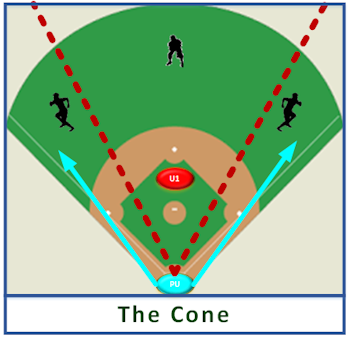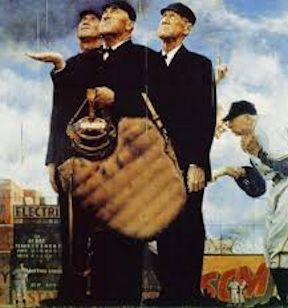 Catch/No-Catch & Going Out
Catch/No-Catch & Going Out
I've reviewed dozens and dozens of umpire mechanics manuals, PowerPoint presentations, PDFs and whatnot, and I've seen enough diagrams of umpire movements and rotations to literally numb the mind. I'm not saying these are misguided efforts; rather, they often tend to take something rather simple and make it way more complicated than it needs to be.
As we did with the Basic Rotations, we're going to simplify. As you gain experience, you can build on these basic principles. But the basics themselves get you 90% of the way to proficiency. And we're going to apply these principles to two issue: who covers catch/no-catch under a given set of circumstances, and when should the field umpire (U1) decide to go out to cover a catch in the outfield. What follows applies to umpires in the two-umpire system.
Catch/no-catch coverage depends on the field umpire's start position. When U1 starts in the A position (that is, when there are no runners on base), there is one set of assignments. However, when U1 is in the B or C positions (with runners on), the situation changes.
Let's start with U1 in A
With U1 in A, on a batted ball to the infield, U1's responsibility is covering the batter-runner to first base and beyond. On a batted ball to the outfield, however, U1 must decide immediately whether to go out on the catch/no-catch, or instead come inside and take the runner.
If U1 decides to go out to cover the catch/no-catch, then the plate umpire takes the batter-runner all the way. If, on the other hand, U1 decides not to go out, but instead to come inside, pivot, and stay with the batter-runner, then the plate umpire has catch/no-catch, as well as fair/foul if the fly ball is near the foul line.
The decision to go out or come inside rests entirely with U1. The plate umpire must read U1's intentions and respond accordingly. That said, there are some guidelines on deciding when to go out and when come inside. The guidelines rest primarily on two issues: (1) the batted ball's location in the outfield, and (2) the nature of the batted ball.
 With respect to U1 going out, there is a huge disconnect between what is written and what actually happens. In most umpire manuals (a good example is the Collegiate Commissioner's Association (CCA) Manual), the "book" has U1 covering all of the outfield from center fielder to the right field line. But you won't see this in practice. In practice, U1 goes out in a much narrower wedge. So that's what I'll call it: the wedge.
With respect to U1 going out, there is a huge disconnect between what is written and what actually happens. In most umpire manuals (a good example is the Collegiate Commissioner's Association (CCA) Manual), the "book" has U1 covering all of the outfield from center fielder to the right field line. But you won't see this in practice. In practice, U1 goes out in a much narrower wedge. So that's what I'll call it: the wedge.
In reality, U1 goes out from the A position far more conservatively than most umpire manuals would have you believe, and the plate umpire (PU) covers far more ground on catch/no-catch coverage.
Here are guidelines to help inform U1's decision to go out:
- If the ball is over U1's head and entails a potential fair/fould call, and the right fielder is racing in the direction of the foul line, then U1 must turn, position himself on the foul line, perhaps take a few steps out, but then get set for the call.
- On a deep fly ("trouble") ball that has the right fielder funning for the fence (or conceivably, the center fielder running hard into the wedge), you should go out for the potential home run call.
- If you see two fielders converging on the same fly ball in the wedge, you should go out for the potential error.
- On a line drive to the outfield that a fielder is running in to field, and which could be a catch below the waist, or even a shoestring catch (or trapped ball), you should go out to get this trouble ball.
Important: When going out on a trouble ball, do not run straight at the fielder attempting the catch. Instead, take a line about 20-30 degrees off the straight line so you get an angle on the catch. This is particularly important when you have a shoestring catch/trapped ball decision to make.
With runners on base
With runners on base, U1 is in either B or C, depending on the base-runner configuration. Regardless of which side of the mound U1 is on, the catch/no-catch mechanics are the same. That is, now U1 owns the catch/no-catch call over the majority of the outfield – over the entirety of the cone. The PU, then, has catch/no-catch in cases where the left or right fielders are moving toward the foul lines to make the catch.
 The cone is that portion of the outfield roughly defined by the left and right fielders moving straight back, straight forward, or moving in toward center field. In simpler terms, if a fly ball is not pulling F7 or F9 toward a foul line, then that fly ball is in the cone and the catch/no-catch call belongs to U1. If the fly ball is pulling F7 or F9 (or, in some cases, F3 or F4) toward a foul line, the fly ball is "on the line" and the catch/no-catch belongs to the PU.
The cone is that portion of the outfield roughly defined by the left and right fielders moving straight back, straight forward, or moving in toward center field. In simpler terms, if a fly ball is not pulling F7 or F9 toward a foul line, then that fly ball is in the cone and the catch/no-catch call belongs to U1. If the fly ball is pulling F7 or F9 (or, in some cases, F3 or F4) toward a foul line, the fly ball is "on the line" and the catch/no-catch belongs to the PU.
It is the responsibility of the PU to call U1 off if he's taking ownership of a fly ball that is on the line. The plate umpire must call loudly (so his partner can hear) "I've got the ball!" (or the 3rd base side), or "I've got the line!" (on the 1st base side).
Important: We're learned elsewhere that, with runners on base, the PU is responsible for base touches and tag ups at third base. However, when the PU takes catch/no-catch on the first base line (and calls I've got the line!), he is no longer in position to see touches and tags at third base, so in this situation he is relieved of that responsibility. U1 must recognize this switch and take over touches and tags at third.
Do we ever go out with runners on?
One the big diamond, the B and C positions are inside the basepath. (See start positions if you need a refresher.) There is an axiom that says you never ever go out from inside the basepath. That is, you never cross the basepath (risking a collision with a base runner) from a position inside.
Here we get to another set of instructions where there is a disconnect between what is written and what actually happens on the field. There are some mechanics manuals (NCAA is one of them) where, in a three-umpire crew, the umpire in B or C is directed to go out to the outfield to cover catch/no-catch from his start position inside the basepath. In that case, the third umpire comes inside from the D position, and then U3 and PU revert to the two-umpire system.
However, I have seen a lot of NCAA baseball games (Divisions I, II, and III) and I have never (not once) seen an umpire cross the basepath to cover catch/no-catch in the outfield. I'm not saying it doesn't happen; I'm just saying I've never seen it.
With regard to the two-umpire system, then, I'm comfortable with the direction to never, ever go out from inside with runner on base. There are two reasons for this – one of them a good reason, the second a really good reason.
First off, there's the issue of a potential collision with a base runner. Why risk it? And the second, even better reason, is that if U1 goes out, then the PU is left alone with the entire infield and all base runners. And that's asking for trouble.
So don't go out from inside. Just don't do it. Rely instead on the cone-and-lines division of responsibilities and let it go at that.
On the Small Diamond
When working the small diamond (60-foot base paths), the coverage changes somewhat.

